The Geography Of Sharing: How Mastering Emotions Can Help Brands Succeed On A Global Scale
Did you know that Australians share branded video content faster than any other country worldwide? Or that the most common reason to share a video online in Japan is to seek other people’s opinions, while in the U.K. it’s to recommend a product or service?
Or, with a month to go to the Rio Olympics, how about that Brazilians are more likely to buy a product or love a brand after viewing an online ad than consumers in the US, South-East Asia and Europe?
Such stats only highlight the complexities and challenges facing global marketers during these digital days. Video offers advertisers a huge opportunity to engage consumers across the globe. Consumption of online video, fuelled by the rise in mobile viewing, is exploding. In just four years the amount of time US adults spend watching digital video has tripled, from 21 minutes every day to 1 hour 18 minutes (source: eMarketer).
So it’s hardly surprising that ad spend in the US alone is expected to almost double by 2019 (source: Forrester Consulting/ Videology). Video is the most social of media – it’s more personal than a static image, more persuasive than written text and more emotive than the spoken word. The unique power of social video lies in its ability to create an emotional connection…and to do so at a speed and scale unimaginable prior to the advent of the social web.
It also delivers ROI. While clickthrough rates for banner ads plummet, video ads deliver results. For example, 41% of US viewers reported having a more favorable view of a brand after watching a video ad, while 40% report that they are more likely to buy a product or service (source: Unruly).
But while the insatiable appetite for digital video is the same all around the world – the way we consume videos and respond to video ads is anything but.
When it comes to online video marketing, there’s no such thing as a one-size-fits-all approach. Like any sports star competing at the Olympics this summer will tell you, every team or challenge you face requires a different set of tactics; a fresh approach.
Unruly has been running online global video campaigns for more than a decade and have even created an algorithm that can predict the shareability of a video ad before it is launched.
Our research has not only revealed the most important factors that make a video shareable but also marked cultural differences in how people consume and share videos online.
So what makes people share videos?
There are a lot of factors that influence the intrinsic shareability of a video, but what are the most important? Well, certainly the strength of emotions a video elicits from its audience is key.
Anyone who’s seen a tear-jerking video get bounced back and forth between their friends knows that strong emotions matter. A sentimental score, a riveting story, or a bit of old-fashioned inspiration: all these often collide to make highly shareable, branded content.
The social motivations an ad campaign gives to share it is also highly important. Humans are complex social beings, and have all sorts of reasons for sharing a video with their friends. Understanding these social motivations is key to tapping into the widest audience possible for your campaign. An ad can have a killer concept and direction by Steven Spielberg, but if viewers have no reason to share, it won’t be big on the social web.
However, creating ads that people want to actually watch is just one part of the puzzle. How you distribute your videos – especially at a time when the number of people using adblockers is on the rise globally – is also crucial.
Polite advertising – polite-page loading, respectful ad formats that give a better user experience, and better ads in the first place – is essential for any brands looking to turn their ad into a global hit.
As is understanding each of the markets you are distributing your content in. Local activation is the key to success and this is where data-driven insight – revealing the subtle differences in online consumption habits by market – can propel campaigns to global success.
But what are the key differences?
1. Viral triggers
As mentioned before, the main drivers of sharing are the strength of the emotional responses it elicits from its target audience and the social motivations it gives consumers to share the content with their social media networks.
But, of course, people’s responses to the same pieces of content can vary greatly. How many times have you been left nonplussed by the latest viral video hit; barely mustering a smile at a video that had your best mate almost sick with laughter? These differences are only exaggerated when you cross national boundaries.
Using the right mix of emotional and social triggers, video campaigns can cross geographical and linguistic borders and be used to kick-start global conversations. But, as the map below shows, the most common drivers of video sharing also differs greatly by territory.
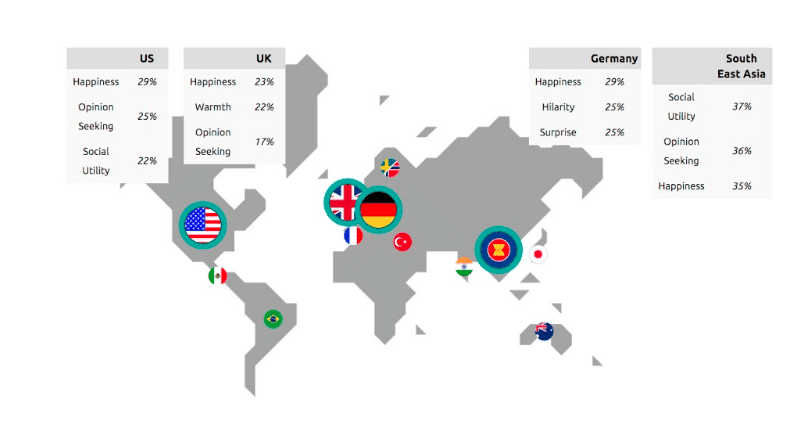
Source: Unruly Pulse
Different emotions resonate more strongly in different countries. In some territories, social motivations to share are more important than emotional triggers.
For example, in the US and Europe, emotions are the key drivers of video sharing, while in South-East Asia, Brazil and Turkey the focus is more on giving consumers reasons to share content.
Some emotions do resonate globally, however. Happiness is the most common emotion globally, which makes it an ideal emotional trigger for brands looking to create content that will resonate across national boundaries, such as ads for the Summer Olympics.
One great example of this is Google Android’s ad “Friends Furever”. The video, which features some unlikely friendships across the animal kingdom, was a huge global hit, attracting over 7 million shares since its launch in February 2015, making it the most shared ad of all time.
There are a number of factors in its success, but the main reason is the strength of emotions it elicited from its audience, particularly the global emotions of happiness and warmth.
As you can see from the chart below, when we tested the ad we found that it made consumers around the globe feel almost four times as happy as the average ad.
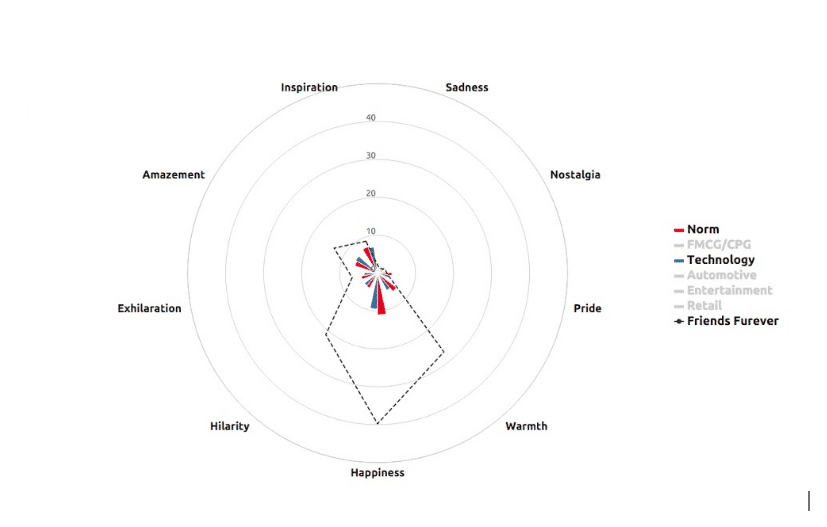
Source: Unruly Pulse
Meanwhile, while “Friends Furever” did manage to make people laugh, hilarity is one of the hardest to get right. A lot of ads try to make us laugh, but our research has found advertisers are failing to make people laugh, with hilarity one of the least common emotions worldwide, felt by 4% of respondents (see below).
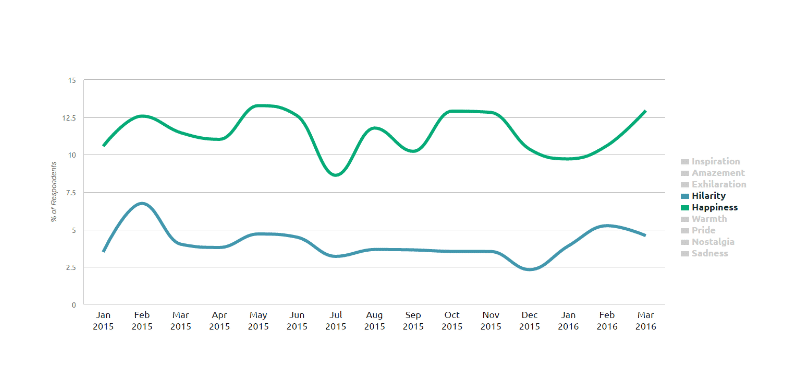
Source: Unruly Pulse
It’s not hard to see why. While happiness is a common goal globally, making people laugh is hard and humour doesn’t always translate across borders.
2. Speed of sharing
When distributing a global video campaign it’s important to understand the rate at which viewers watch and share videos. Time it right and you can generate a lot of earned media. Get it wrong, and you face an uphill battle and little chance of organic spread.
But just when in a video’s lifecycle does it attract the most shares? Well, you might be surprised to hear that 43.8% of an average online branded video’s total shares occur in the first three days of its launch,
It means marketers have a relatively small window in which to make an impact. However, these averages not only differ greatly by platform – with the rate of sharing occurring a lot quicker on Facebook Video than YouTube – but also territory by territory.
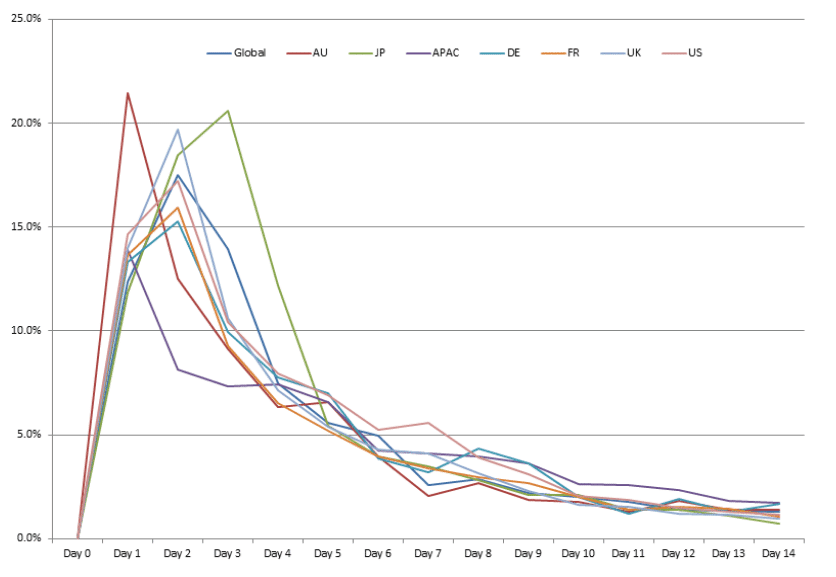
Source: Unruly Pulse
For example, in Australia the first 24 hours are crucial, with the average Australian ad generating 21.4% of its total shares within the first day of its launch – making it the fastest worldwide and much higher than the global average of 12.4%.
Japanese ads get off to a much slower start, with the average ad attracting only 11.8% of its total shares in the first 24 hours, making Japanese consumers the slowest sharers among the big global ad markets.
However, the rate soon picks up on the second day and overtakes the rest of the world by the third, with the average Japanese ad attracting more than half (50.9%) of its total shares in the first three days, more than any other nation. Meanwhile, APAC ads attract the lowest number percentage of shares in this crucial opening period (29.4%).
The day of the campaign in which sharing peaks also differs by territory. While in Australia and APAC sharing peaks on the first day of launch, sharing in the UK (19.7%), France (16.0%) and the U.S. (17.2%) peaks on the second day. Meanwhile, Japanese sharing activity peaks on the third day (20.6%).
3. Brand uplifts
But how do different nationalities respond to video ads? Well, Brazil is not only the home of this year’s Summer Olympics, it’s also the home of online video.
Brazilians are more likely to buy a product or love a brand after viewing an online ad than consumers in the US, South-East Asia and Europe
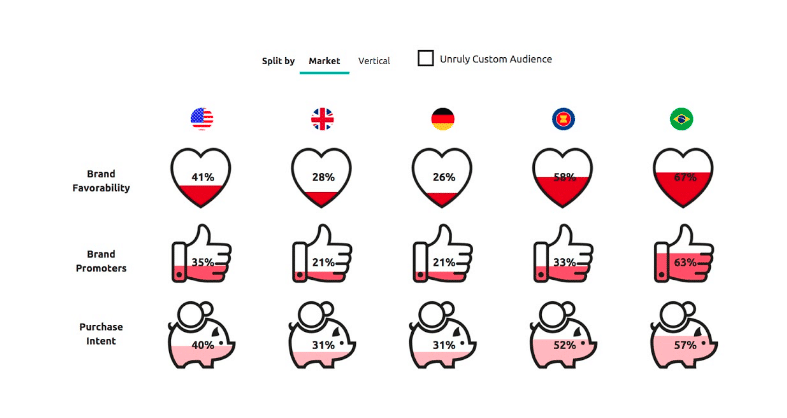
Source: Unruly Pulse
Two-thirds of Brazilians have a more favourable view of a brand after watching an ad, compared with 58% across ASEAN markets and 41% in the US. Audiences in Europe, on the other hand, are a lot more cynical when it comes to video, with only 28% of viewers in the UK and 26% in Germany more likely to like a brand after watching an ad.
Purchase intent is also highest in Brazil, with 57% claiming they would buy a product post-viewing compared with 52% across ASEAN markets, 40% in the US, and 31% in the UK and Germany.
